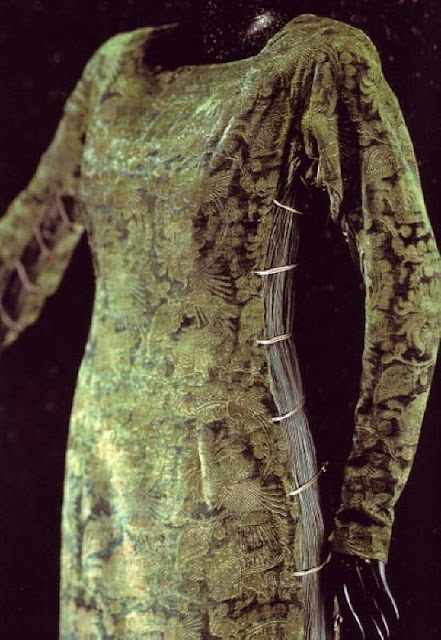Fortuny e Caramba
In the last of my Fortuny series I bring you my favorite, his silk velvet. Fortuny grew up around textiles as both his parents had shops and collected textiles and he was an avid collector himself in adulthood. So it wasn�t unusual for a man who was an artist to want to experiment with the old methods of dying on fabrics. As it turned out it was the theatre that really brought his love of fabrics alive.
Fortuny e Caramba
Fortuny was sketching and designing costumes for the theatre and his first try at designing wasn�t a great success mainly because the costumes were to heavy and hampered the performers movements. This led Fortuny to experiment with a lighter weight fabric such as silk and then velvet for both his home and dresses.
Mariano Fortuny: His Life and Work
Fortuny was not interested in fashion as we know it, had no desire to be a couturier but was an artist who just happened to create clothes. The clothes themselves came from his knowledge of Greek and Venetian clothes that he painted in his paintings. He loved free flowing styles and to be honest the time period of styles was changing to clothing that was lighter and freer in movement.
Paper Illusions by Isabelle de Borchgrave
He went on to patent a dress in a Greek free flowing style that was executed in pleated silk known as his Delphos. The Delphos dresses were kept very simple and in solid colors allowing Fortuny to reinterpret historical designs from the Renaissance and 16th century Venetian art onto simply cut velvet jackets, wraps, mantles and capes. The over pieces are what allowed Fortuny to bring in color and his favorite design motifs.
Fashion Memoir: Fortuny by Delphine Desveaux
All the dresses were produced in the studio at the Palazzo Orfei and were all made by hand, individually, as were all the materials that went into them. The pleated and printed silk, the velvets, the cords that were used to gather the different parts, everything except for the glass beads, the glass beads were ordered from the Murano glass factory.
Metropolitan Museum Collection
Persepolis pattern, which is a Persian design, named for the ancient city and still produced today.
Metropolitan Museum Collection
Moresco pattern in an early Moorish style and still produced today.
My pillows in my personal collection, the blue is Fortuny's Clamys design, the green is a 16th century design
The velvet Fortuny used was a very light silk velvet that he imported from France and came in its raw state of white or slightly creamy. The whole process from raw materials to the final result depended on Fortuny. He produced the dyes, the colors, the blocks or stencils and the machines. Gives a new appreciation into his world and work.
My image
The designs on his velvets were usually layered on and he never used chemical colors but produced his own natural colors. He imported all the different ingredients from all over the world and then experimented with the colors in his studio. Look at the rich background color, Fortuny produced and dyed the velvets before applying the design. This is what makes Fortuny�s dresses less of a garment and more of a work of art.
My image
You can see that his velvets have a very low pile and while Fortuny was dying and stenciling on the velvets they went through a water wash many times over. You can�t do that with today�s velvets without ruining the pile. Unlike the softness of today�s silk velvets Fortunys' velvets are rough to the touch.
My image
Fortuny labeled his velvets with silk faille labels that he made himself and are coveted today when purchasing his silk velvet and I feel very fortunate to have two labels. If you�re ever lucky enough to come across a fragment of Fortuny�s silk velvet be forewarned a small piece big enough for a single pillow can cost over a thousand dollars.
Fortuny e Caramba
While I know this post is about Fortuny�s silk velvets there�s one area I haven�t touched on in his work and that�s his silk appliqu� work. Not many people chase after his appliqu�s mainly because he designed these for the theatre and not many examples still exist today. I thought I would show one amazing example for you to see and this piece was design using a medieval motif.
Stephen Shubel, House & Garden
I even managed to find one interior design picture where Stephen Shubel used a piece of Fortuny�s silk velvet on a chaise. The hanging light fixture is also Fortuny�s design showing how timeless his pieces are today.
So we have the theatre to thank for Fortuny getting into textiles and the silk velvets lead to him producing a more affordable line of fabrics like the cottons. The theatre is also responsible for him producing his line of lighting as well. My post gives only a brief explanation of his textile background and I hope if this has tantalized your interest you�ll pick up a copy of one of the many books out today and have a great read. Fortuny�s life is really one of a work of art.
I hope you all have a really enjoyable week with whatever opportunity it may bring you!
XX
~Debra~























0 komentar:
Posting Komentar